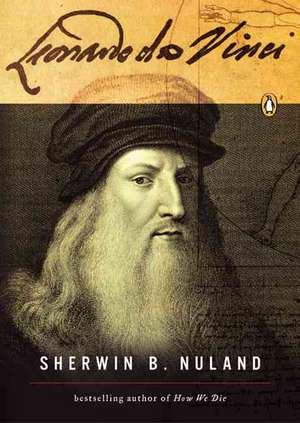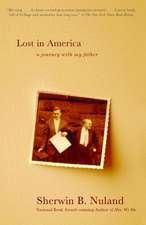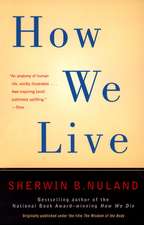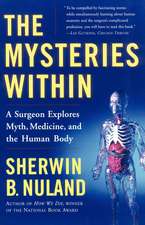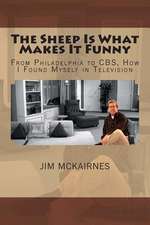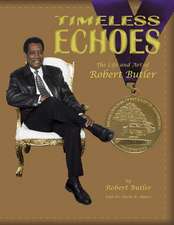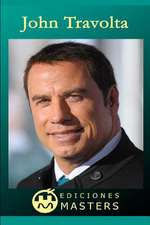Leonardo Da Vinci: A Life: Penguin Lives Biographies
Autor Sherwin B. Nulanden Limba Engleză Paperback – 31 dec 2004 – vârsta de la 18 ani
The life and work of the great Italian Renaissance artist and scientist Leonardo da Vinci (1452ߝ1519) have proved endlessly fascinating for generations. In Leonardo da Vinci, Sherwin Nuland completes his twenty-year quest to understand an unlettered man who was a painter, architect, engineer, philosopher, mathematician, and scientist. What was it that propelled Leonardo’s insatiable curiosity? Nuland finds clues in his subject’s art, relationships, and scientific studies—as well as in a vast quantity of notes that became widely known in the twentieth century. Scholarly and passionate, Nuland’s Leonardo da Vinci takes us deep into the first truly modern, empirical mind, one that was centuries ahead of its time.
Preț: 126.98 lei
Nou
Puncte Express: 190
Preț estimativ în valută:
24.30€ • 25.43$ • 20.22£
24.30€ • 25.43$ • 20.22£
Carte disponibilă
Livrare economică 10-24 martie
Preluare comenzi: 021 569.72.76
Specificații
ISBN-13: 9780143035107
ISBN-10: 014303510X
Pagini: 176
Ilustrații: b/w illustrations on pages 126, 157, and 163
Dimensiuni: 129 x 181 x 12 mm
Greutate: 0.12 kg
Editura: Penguin Books
Seria Penguin Lives Biographies
ISBN-10: 014303510X
Pagini: 176
Ilustrații: b/w illustrations on pages 126, 157, and 163
Dimensiuni: 129 x 181 x 12 mm
Greutate: 0.12 kg
Editura: Penguin Books
Seria Penguin Lives Biographies
Recenzii
"[Nuland’s] own professional expertise enables him to write with particular insight and authority." —The New York Review of Books
"In this brief life, Nuland summarizes Leonardo’s achievements skillfully." —Scientific American
"Nuland’s enthusiasm and knowledge make his story interesting and easy to read." —The Seattle Times
"In this brief life, Nuland summarizes Leonardo’s achievements skillfully." —Scientific American
"Nuland’s enthusiasm and knowledge make his story interesting and easy to read." —The Seattle Times
Notă biografică
Sherwin Nuland, M.D., is the author of bestselling nonfiction titles including How We Die, for which he won the National Book Award. He is clinical professor of surgery at Yale University, where he also teaches medical history and bioethics.
Extras
Chapter One
Searching for the Man
In the eighth year of my near-idolatrous fascination with the life of Leonardo da Vinci, I made a pilgrimage to the house where he was born. Or so I thought.
It was 1985, and my wife, Sarah, and I were in Florence. On our second morning in the city, without a moment's forethought, we precipitously decided to visit Vinci, where neither of us had been before.
What better place to go for directions than the Museo di Storia della Scienza? Finding it closed, I knocked on the massive wooden door, and to my surprise it was opened just a crack by a woman who heard me out and then went inside to ask the direttore for advice. She quickly returned with her boss, and Sarah and I soon found ourselves on the train to Empoli, a distance of about twelve kilometers. From there we took a short bus ride to Vinci. Vinci proved to be a town indistinguishable from most others in the area, except that it had a small museum where models of Leonardo-inspired machines were available for inspection. And there was something else. Large signs pointed the way to La Casa Natale di Leonardo-the great man's birthplace-said to lie at a distance of three kilometers. What the signs did not say was that the three kilometers were entirely up a steep hill, which we now proceeded to climb. Upon having hauled ourselves up to the top, we were rewarded by the presence of a large stone building, clearly the ruin of a Renaissance house. We had arrived at the very place.
Strangely, neither Sarah nor I felt the sense of elation we had expected. The inside of the structure consisted of a single largestone-floored room with a wide hearth at one end. An elderly woman was selling souvenir postcards. There was nothing else, either physically or spiritually. Whatever we had expected to find was not there.
A few other tourists wandered aimlessly through the space, looking as disappointed as we did. I tried to counterfeit enthusiasm for Sarah's sake and she did the same for mine, but nothing availed. After all the effort to get to the natal place of my hero, the result was anticlimactic. Still, it was his birthplace, even if its austere old bricks seemed to have no message for us. At first, we were reluctant to leave, continuing, I suppose, to cling to the hope that one or the other of us would be seized with inspiration by just the thought of our being there. When about twenty minutes of this had no demonstrable issue, we made up our minds to leave. Hitching a ride in a German tourist's Mercedes, we made short work of getting back to the center of town. Absent the anticipation of the ascent, the ride down the long hill was depressing. It had been a drought year in 1984-every olive tree was still barren and shriveled, the grass was brown, and the soil was parched and almost sandy. In such an atmosphere, it was difficult to conjure up the classic image of the golden-haired child Leonardo becoming ever more enthralled by the beauties of all the magnificence of living nature around him, as he gamboled in the lush beauty of the surrounding fields.
And there was worse to come. Some long time later, I came to realize through my reading and conversations with Italian friends that no one has any idea where Leonardo was born. In fact, his natal house may not even have been in Vinci. According to some, he was born in the nearby town of Anchiano and brought to Vinci only after a few years, or perhaps it was a few months. Sarah and I may have been in the house where he was born, but then again we may not. To add to the confusion, we later found out that our walk up the hill had taken us out of Vinci and into Anchiano itself, whose citizens consider the Casa Natale di Leonardo to be a hoax perpetrated on gullible tourists.
Leonardo was not to be found in that place. In fact, he is not to be found in any place. He is not a creature of places or monuments or even of permanence. He flashed across his time and was gone, leaving a vast body of work almost none of which except the paintings could be fully appreciated until centuries after his death, and far away from the house in which he was almost certainly not born. Quoting the famous statement of Freud, "He was like a man who awoke too early in the darkness, while the others were all still asleep," the eminent Vincian scholar Ladislao Reti has followed the image by pointing out how many of Leonardo's manuscripts disappeared into that darkness. It is only through the relatively recent rediscovery of some of them that the enigma of his genius is being illuminated. And yet he remains, and always will, precisely what Reti calls him: the unknown Leonardo.
Leonardo da Vinci was a creature of ideas. In some ways, he is elusive; in others, he is so close to us that his voice is easily heard. Far more is known about his thought and the great range of his mind than about the actual events and circumstances of his life. But even his thought must remain always somewhat obscure to us. If he is, as Sir Kenneth Clark so appropriately calls him, "the most relentlessly curious man in history," he is also the historical figure about whom we are most relentlessly curious.
As Leonardo must ultimately remain unknown to us, so did the restraints remain to him, that perforce stood in the way of his achieving his objectives as a student of nature. Without the instruments, the mathematics, the experimental methods of a later time, he could not have known in which direction to set out so that he might achieve his final aim, which was a systematization of all knowledge of nature. So he struck out in every direction at once, and the greatest of wonders is how much he was able to achieve in the absence of technologies and information that would be available only to modern thinkers. He has been criticized, now and in his own time, for finishing so little of what he started. And yet, how could it have been otherwise, at least in the areas of his scientific work? The probings of his mind had gone well beyond the supporting knowledge and technology of his era. Had much more been available, it would certainly have released his genius to fly as far in reality as it did in his conjectures and fantasies. Kenneth Keele, the foremost authority on Leonardo's anatomical studies, once sent me a paragraph extracted from a letter to a mutual friend, in which he described his own feelings about these matters, aroused while he was working on some of Leonardo's manuscripts:
At every page I am fascinated by his intelligent questions and answers. But I often find myself realizing that however intelligent, however full of instinctive weight the questions are, if the supporting base of knowledge is not there the answers are bound to contain errors. This makes my tale inevitably one tinged with sadness; and the more Leonardo struggles within his chains of ignorance the sadder it becomes. Especially is this so because though he breaks his fetters in many places he never escapes from them. I wonder if in a number of fields (I would cite sociology, psychology, thanatology) we are not in a rather similarly sad state today with the fetters being no less powerful for being unknown to us, even unfelt.
Of course, it is true that just as we have no way of knowing or even estimating the fences and fetters that still restrict even such mathematics-based studies as physics and astronomy in our day-let alone the fuzzier fields of Keele's concern-Leonardo could not have known the fifteenth century's limitations to his possible accomplishments. As he saw it, there were no boundaries and no impossibilities; hard work and constant application would solve all riddles. "God sells us all good things at the price of labor," he wrote, quoting from Horace. But he (as well as Horace) was wrong, and not only because his ideas outstripped his era. Though he was a man well beyond his time, he was yet a man of his time and subject to certain deeply internalized preconceptions by which he was unknowingly led into error in some of his interpretations. As much as he denied it and tried to avoid it, he was nevertheless silently influenced by the formulations of his predecessors and restricted by the spirit of the Renaissance. As free and open as that spirit has been proclaimed to have been, it was only so in comparison to what had come before. Leonardo needed the seventeenth century, or perhaps the twentieth. It was not only the spirit of a later era that was needed, but its very knowledge and the lessening of the inherent biases of earlier times. Failing that, even this expansive reach of man's intellect must leave us with the sadness Keele felt, that it could not have been otherwise.
And yet, despite the limitations imposed by those unavoidable fetters, Leonardo's was a modern mind, the first of its kind that posterity can look back on. Like every true scientist of every era, he was taught by nature, and determined never consciously to allow himself to be slave to the thinking of the past. That the past sometimes entered unknowingly into his interpretations of what he saw should not blind us to the detachment with which he attempted to make his observations. His writings refer only infrequently to the great men of antiquity. He fought powerfully against the unseen temptations of his intellectual heritage, and won far more often than he lost. "Anyone who in discussion relies upon authority uses not his understanding but his memory," he wrote. In the last analysis, he trusted only what he could see in his own studies. Those misinterpretations that inevitably crept into his writings were the result of an inherited tradition so pervasive that even the thinking of a genius of such magnitude could not entirely escape them.
Though he has often been called the ultimate Renaissance man, there is much to be said for the argument that Leonardo was only in part a man of the Renaissance. While he epitomized the zest for life and nature that was the guiding theme of humanism, he did at the same time eschew the dependence on ancient sources and the worshipful repetition of its principles that equally characterized its scholarship. "Those who study the ancients and not the works of Nature," he wrote, "are stepsons and not sons of Nature, the mother of all good authors." He was the first to approach the pronouncements of the Aristot-les, Ptolemys, and Galens as teachings to be tested and challenged rather than as teachings to be necessarily accepted and verified. That his basic frame of reference originated in their writings meant only that he was, indeed, a fallible man of his time; some of his greatest errors and missed opportunities resulted from that background of classical thought which he could not escape. His astronomy was largely Ptolemaic and his physiology Galenic. But when the objectivity of his eye showed him otherwise as he came to "abundantly appreciate the infinite works of nature," he did not hesitate to say so. And this is why we find in one of his notebooks such jots as a statement astonishing for its time: "The sun does not move." As his ultimate direction was to question the heritage of earlier ages and seek only the truth of his own experience, he was able to blaze new paths through territories that his contemporaries believed to have been correctly charted long before their time.
The theme of Leonardo's science is the experimental method, an approach to the study of nature said not to have been introduced until the seventeenth century. The experimental method was the key to the so-called Scientific Revolution, for which that century is renowned. But Leonardo had already awakened in the darkness. Had he stayed abed two hundred years longer, he would have been far less fettered and the beneficiary of far more knowledge and technology than he was. Who can doubt that he might have left a heritage to rival-and probably exceed-those of such as Kepler, Galileo, Harvey, and even Isaac Newton?
This is the Leonardo da Vinci who has fascinated me all these years, and particularly the anatomist in him. The magnificence of his artistic gifts and the splendor of his paintings are well known to the world. He lived, after all, in a time when artistic achievement was the glory of princes and populace alike. Giorgio Vasari, a generation later writing as an artist about artists, left to the world an indelible image of a Leonardo "truly admirable indeed, and divinely endowed. He might have been a scientist if he had not been so versatile. But the instability of his character caused him to take up and abandon many things." These words, in the 1568 edition of Vasari's Lives of the Artists, were written long before any comprehension of Leonardo's scientific accomplishments was possible. Like so many others of the time, Vasari saw him as far less productive an artist than he might have been had he not trifled with science. What was mistaken for instability was only Leonardo's itch to get back to scientific work, from which he too often felt distracted by the more practical matters of artistic productivity. There were long periods when he actually became impatient with painting. Thus, in a letter attempting to explain to an eager patroness, Isabella d'Este of Mantua, why a commissioned portrait of her was delayed, Fra Pietro di Novellara, the vicar general of the Carmelite Order, wrote to her in April 1501, "[H]is mathematical experiments have so estranged him from painting that he cannot bear to take up the brush." Such an attitude was incomprehensible to all but a few of his colleagues and patrons. Though Vasari marveled at the anatomical studies, he believed that Leonardo's heir, Francesco Melzi, merely "treasures these drawings as relics," for that was thought to be their only value.
We know far better today. We know that although Leonardo initiated his anatomical studies in order to enhance his art, they in time became an enthusiasm unto themselves, and finally one of the major endeavors on which his genius was focused. We know, moreover, that, as in many other matters, he leaped so far ahead of his time that even he could not appreciate the trajectory upon which he had embarked. The medical historian Charles Singer has said of him, "[H]is anatomical notebooks...have revealed him for what he was: one of the greatest biological investigators of all time. In endless matters he was centuries ahead of his contemporaries." And we know something further: The more the manuscripts of Leonardo are studied, the more one begins to see him not so much as a transcendent artist, but as primarily a man of science, whose skills and commissions as an artist and engineer enabled him to support his fascination with nature.
Not only is it the anatomy of Leonardo that has obsessed me, but his elusiveness as well. Struggling to the top of a steep hill in Vinci or Anchiano and finding nothing more than a "perhaps" seems symbolic of the problem faced not only by the professional Leonardo scholars, but by the rest of us as well, struggling to comprehend who he was. The dates, the facts, the known events are far fewer than we need if we are to understand how such a being could have existed. The enigma of the Mona Lisa's smile is not less than the enigma of her creator's life force. Or perhaps that smile is in itself Leonardo's ultimate message to the ages: There is even more to me than you can ever capture; though I have spoken so intimately to you in my notebooks even as I have spoken to myself, I have kept final counsel only with the depths of my spirit and the inscrutable source that has made me possible; seek as you may, I will commune with you only so far; the rest is withheld, for it was my destiny to know things you will never know.
Searching for the Man
In the eighth year of my near-idolatrous fascination with the life of Leonardo da Vinci, I made a pilgrimage to the house where he was born. Or so I thought.
It was 1985, and my wife, Sarah, and I were in Florence. On our second morning in the city, without a moment's forethought, we precipitously decided to visit Vinci, where neither of us had been before.
What better place to go for directions than the Museo di Storia della Scienza? Finding it closed, I knocked on the massive wooden door, and to my surprise it was opened just a crack by a woman who heard me out and then went inside to ask the direttore for advice. She quickly returned with her boss, and Sarah and I soon found ourselves on the train to Empoli, a distance of about twelve kilometers. From there we took a short bus ride to Vinci. Vinci proved to be a town indistinguishable from most others in the area, except that it had a small museum where models of Leonardo-inspired machines were available for inspection. And there was something else. Large signs pointed the way to La Casa Natale di Leonardo-the great man's birthplace-said to lie at a distance of three kilometers. What the signs did not say was that the three kilometers were entirely up a steep hill, which we now proceeded to climb. Upon having hauled ourselves up to the top, we were rewarded by the presence of a large stone building, clearly the ruin of a Renaissance house. We had arrived at the very place.
Strangely, neither Sarah nor I felt the sense of elation we had expected. The inside of the structure consisted of a single largestone-floored room with a wide hearth at one end. An elderly woman was selling souvenir postcards. There was nothing else, either physically or spiritually. Whatever we had expected to find was not there.
A few other tourists wandered aimlessly through the space, looking as disappointed as we did. I tried to counterfeit enthusiasm for Sarah's sake and she did the same for mine, but nothing availed. After all the effort to get to the natal place of my hero, the result was anticlimactic. Still, it was his birthplace, even if its austere old bricks seemed to have no message for us. At first, we were reluctant to leave, continuing, I suppose, to cling to the hope that one or the other of us would be seized with inspiration by just the thought of our being there. When about twenty minutes of this had no demonstrable issue, we made up our minds to leave. Hitching a ride in a German tourist's Mercedes, we made short work of getting back to the center of town. Absent the anticipation of the ascent, the ride down the long hill was depressing. It had been a drought year in 1984-every olive tree was still barren and shriveled, the grass was brown, and the soil was parched and almost sandy. In such an atmosphere, it was difficult to conjure up the classic image of the golden-haired child Leonardo becoming ever more enthralled by the beauties of all the magnificence of living nature around him, as he gamboled in the lush beauty of the surrounding fields.
And there was worse to come. Some long time later, I came to realize through my reading and conversations with Italian friends that no one has any idea where Leonardo was born. In fact, his natal house may not even have been in Vinci. According to some, he was born in the nearby town of Anchiano and brought to Vinci only after a few years, or perhaps it was a few months. Sarah and I may have been in the house where he was born, but then again we may not. To add to the confusion, we later found out that our walk up the hill had taken us out of Vinci and into Anchiano itself, whose citizens consider the Casa Natale di Leonardo to be a hoax perpetrated on gullible tourists.
Leonardo was not to be found in that place. In fact, he is not to be found in any place. He is not a creature of places or monuments or even of permanence. He flashed across his time and was gone, leaving a vast body of work almost none of which except the paintings could be fully appreciated until centuries after his death, and far away from the house in which he was almost certainly not born. Quoting the famous statement of Freud, "He was like a man who awoke too early in the darkness, while the others were all still asleep," the eminent Vincian scholar Ladislao Reti has followed the image by pointing out how many of Leonardo's manuscripts disappeared into that darkness. It is only through the relatively recent rediscovery of some of them that the enigma of his genius is being illuminated. And yet he remains, and always will, precisely what Reti calls him: the unknown Leonardo.
Leonardo da Vinci was a creature of ideas. In some ways, he is elusive; in others, he is so close to us that his voice is easily heard. Far more is known about his thought and the great range of his mind than about the actual events and circumstances of his life. But even his thought must remain always somewhat obscure to us. If he is, as Sir Kenneth Clark so appropriately calls him, "the most relentlessly curious man in history," he is also the historical figure about whom we are most relentlessly curious.
As Leonardo must ultimately remain unknown to us, so did the restraints remain to him, that perforce stood in the way of his achieving his objectives as a student of nature. Without the instruments, the mathematics, the experimental methods of a later time, he could not have known in which direction to set out so that he might achieve his final aim, which was a systematization of all knowledge of nature. So he struck out in every direction at once, and the greatest of wonders is how much he was able to achieve in the absence of technologies and information that would be available only to modern thinkers. He has been criticized, now and in his own time, for finishing so little of what he started. And yet, how could it have been otherwise, at least in the areas of his scientific work? The probings of his mind had gone well beyond the supporting knowledge and technology of his era. Had much more been available, it would certainly have released his genius to fly as far in reality as it did in his conjectures and fantasies. Kenneth Keele, the foremost authority on Leonardo's anatomical studies, once sent me a paragraph extracted from a letter to a mutual friend, in which he described his own feelings about these matters, aroused while he was working on some of Leonardo's manuscripts:
At every page I am fascinated by his intelligent questions and answers. But I often find myself realizing that however intelligent, however full of instinctive weight the questions are, if the supporting base of knowledge is not there the answers are bound to contain errors. This makes my tale inevitably one tinged with sadness; and the more Leonardo struggles within his chains of ignorance the sadder it becomes. Especially is this so because though he breaks his fetters in many places he never escapes from them. I wonder if in a number of fields (I would cite sociology, psychology, thanatology) we are not in a rather similarly sad state today with the fetters being no less powerful for being unknown to us, even unfelt.
Of course, it is true that just as we have no way of knowing or even estimating the fences and fetters that still restrict even such mathematics-based studies as physics and astronomy in our day-let alone the fuzzier fields of Keele's concern-Leonardo could not have known the fifteenth century's limitations to his possible accomplishments. As he saw it, there were no boundaries and no impossibilities; hard work and constant application would solve all riddles. "God sells us all good things at the price of labor," he wrote, quoting from Horace. But he (as well as Horace) was wrong, and not only because his ideas outstripped his era. Though he was a man well beyond his time, he was yet a man of his time and subject to certain deeply internalized preconceptions by which he was unknowingly led into error in some of his interpretations. As much as he denied it and tried to avoid it, he was nevertheless silently influenced by the formulations of his predecessors and restricted by the spirit of the Renaissance. As free and open as that spirit has been proclaimed to have been, it was only so in comparison to what had come before. Leonardo needed the seventeenth century, or perhaps the twentieth. It was not only the spirit of a later era that was needed, but its very knowledge and the lessening of the inherent biases of earlier times. Failing that, even this expansive reach of man's intellect must leave us with the sadness Keele felt, that it could not have been otherwise.
And yet, despite the limitations imposed by those unavoidable fetters, Leonardo's was a modern mind, the first of its kind that posterity can look back on. Like every true scientist of every era, he was taught by nature, and determined never consciously to allow himself to be slave to the thinking of the past. That the past sometimes entered unknowingly into his interpretations of what he saw should not blind us to the detachment with which he attempted to make his observations. His writings refer only infrequently to the great men of antiquity. He fought powerfully against the unseen temptations of his intellectual heritage, and won far more often than he lost. "Anyone who in discussion relies upon authority uses not his understanding but his memory," he wrote. In the last analysis, he trusted only what he could see in his own studies. Those misinterpretations that inevitably crept into his writings were the result of an inherited tradition so pervasive that even the thinking of a genius of such magnitude could not entirely escape them.
Though he has often been called the ultimate Renaissance man, there is much to be said for the argument that Leonardo was only in part a man of the Renaissance. While he epitomized the zest for life and nature that was the guiding theme of humanism, he did at the same time eschew the dependence on ancient sources and the worshipful repetition of its principles that equally characterized its scholarship. "Those who study the ancients and not the works of Nature," he wrote, "are stepsons and not sons of Nature, the mother of all good authors." He was the first to approach the pronouncements of the Aristot-les, Ptolemys, and Galens as teachings to be tested and challenged rather than as teachings to be necessarily accepted and verified. That his basic frame of reference originated in their writings meant only that he was, indeed, a fallible man of his time; some of his greatest errors and missed opportunities resulted from that background of classical thought which he could not escape. His astronomy was largely Ptolemaic and his physiology Galenic. But when the objectivity of his eye showed him otherwise as he came to "abundantly appreciate the infinite works of nature," he did not hesitate to say so. And this is why we find in one of his notebooks such jots as a statement astonishing for its time: "The sun does not move." As his ultimate direction was to question the heritage of earlier ages and seek only the truth of his own experience, he was able to blaze new paths through territories that his contemporaries believed to have been correctly charted long before their time.
The theme of Leonardo's science is the experimental method, an approach to the study of nature said not to have been introduced until the seventeenth century. The experimental method was the key to the so-called Scientific Revolution, for which that century is renowned. But Leonardo had already awakened in the darkness. Had he stayed abed two hundred years longer, he would have been far less fettered and the beneficiary of far more knowledge and technology than he was. Who can doubt that he might have left a heritage to rival-and probably exceed-those of such as Kepler, Galileo, Harvey, and even Isaac Newton?
This is the Leonardo da Vinci who has fascinated me all these years, and particularly the anatomist in him. The magnificence of his artistic gifts and the splendor of his paintings are well known to the world. He lived, after all, in a time when artistic achievement was the glory of princes and populace alike. Giorgio Vasari, a generation later writing as an artist about artists, left to the world an indelible image of a Leonardo "truly admirable indeed, and divinely endowed. He might have been a scientist if he had not been so versatile. But the instability of his character caused him to take up and abandon many things." These words, in the 1568 edition of Vasari's Lives of the Artists, were written long before any comprehension of Leonardo's scientific accomplishments was possible. Like so many others of the time, Vasari saw him as far less productive an artist than he might have been had he not trifled with science. What was mistaken for instability was only Leonardo's itch to get back to scientific work, from which he too often felt distracted by the more practical matters of artistic productivity. There were long periods when he actually became impatient with painting. Thus, in a letter attempting to explain to an eager patroness, Isabella d'Este of Mantua, why a commissioned portrait of her was delayed, Fra Pietro di Novellara, the vicar general of the Carmelite Order, wrote to her in April 1501, "[H]is mathematical experiments have so estranged him from painting that he cannot bear to take up the brush." Such an attitude was incomprehensible to all but a few of his colleagues and patrons. Though Vasari marveled at the anatomical studies, he believed that Leonardo's heir, Francesco Melzi, merely "treasures these drawings as relics," for that was thought to be their only value.
We know far better today. We know that although Leonardo initiated his anatomical studies in order to enhance his art, they in time became an enthusiasm unto themselves, and finally one of the major endeavors on which his genius was focused. We know, moreover, that, as in many other matters, he leaped so far ahead of his time that even he could not appreciate the trajectory upon which he had embarked. The medical historian Charles Singer has said of him, "[H]is anatomical notebooks...have revealed him for what he was: one of the greatest biological investigators of all time. In endless matters he was centuries ahead of his contemporaries." And we know something further: The more the manuscripts of Leonardo are studied, the more one begins to see him not so much as a transcendent artist, but as primarily a man of science, whose skills and commissions as an artist and engineer enabled him to support his fascination with nature.
Not only is it the anatomy of Leonardo that has obsessed me, but his elusiveness as well. Struggling to the top of a steep hill in Vinci or Anchiano and finding nothing more than a "perhaps" seems symbolic of the problem faced not only by the professional Leonardo scholars, but by the rest of us as well, struggling to comprehend who he was. The dates, the facts, the known events are far fewer than we need if we are to understand how such a being could have existed. The enigma of the Mona Lisa's smile is not less than the enigma of her creator's life force. Or perhaps that smile is in itself Leonardo's ultimate message to the ages: There is even more to me than you can ever capture; though I have spoken so intimately to you in my notebooks even as I have spoken to myself, I have kept final counsel only with the depths of my spirit and the inscrutable source that has made me possible; seek as you may, I will commune with you only so far; the rest is withheld, for it was my destiny to know things you will never know.
Descriere
National Book Award winner Nuland "distills one of the greatest minds ever into its pure essence . . . truly awe-inspiring" ("Time"). Illustrations.
